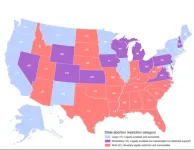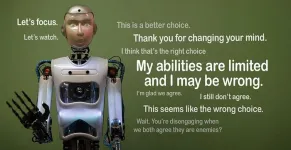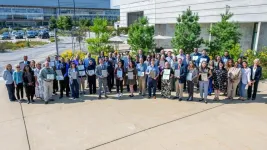(Press-News.org) The built environment — which includes the construction and operation of buildings, highways, bridges and other infrastructure — is responsible for close to 40 percent of the global greenhouse gas emissions contributing to climate change.
While many building codes and benchmarks have focused on constructing “greener,” more energy-efficient new buildings, it is not enough to seek to reduce emissions in operations, said Ming Hu, the associate dean for research, scholarship and creative work in Notre Dame’s School of Architecture. Rather, policymakers and industry leaders must take a broader view by examining the role of embodied carbon in existing buildings.
Embodied carbon represents the amount of greenhouse gas emissions associated with the entire life cycle of a product, including the extraction, production and transfer of materials; the manufacture of the product or building; and its eventual disposal or demolition. In the construction field, materials such as asphalt, concrete and steel, in particular, have dire consequences for the environment.
The impact of embodied carbon in the built environment has been difficult to assess, however, due to a lack of data. To address that knowledge gap, Hu and Siavash Ghorbany, a Notre Dame graduate student in civil and environmental engineering, have created a new way to analyze the embodied carbon in more than 1 million buildings in Chicago.
Their recently published research identifies 157 different architectural housing types in the city and provides the first ever visual analysis tool to evaluate embodied carbon at a granular level and to help inform policymakers seeking to strategically plan for urban carbon mitigation.
“Before, it was often difficult to visualize this concept and to make a case for why we want to preserve and reuse existing buildings,” Hu said. “We feel this is a more clear, direct way to help the policymaker or layperson make informed decisions. If I were the mayor of Chicago, I could look at this and say, ‘OK, before I tear down this building, I have to think twice because there’s already a lot of carbon embedded in this structure. Do I want to retrofit and reuse this building, or do I want to knock it down and build new, which will increase the overall embodied carbon?’”
Hu and Ghorbany were able to identify emissions-intensive geographic zones and specific archetypes within the city — delivering actionable data to urban development stakeholders. They also found that increasing the average lifespan of buildings from the current 50 years to 75 years, and reducing their size by just 20 percent, can decrease their carbon emissions by two-thirds.
Hu emphasized that her research has found no scenario where tearing down an existing building to build something new — even if that new building is more energy efficient — makes sense, from an environmental perspective.
“If we look at the building’s entire lifespan, renovating the existing building has significantly lower carbon emissions over its whole life cycle, including operational and embodied carbon,” said Hu, who is also an affiliated faculty member in the College of Engineering. “That’s because the ‘payback period’ for constructing a new building is typically 20 years due to the high level of greenhouse gas emissions created by its construction. So, if we can extend a building’s life cycle to 70 or 80 years, then reusing the existing building definitely makes more sense.
“We should always reuse existing buildings. The real question is just to what extent we want to renovate and retrofit them.”
Hu and Ghorbany selected Chicago for a number of reasons, including its close proximity to Notre Dame, its architectural history — and because the city is ranked as the 8th highest for greenhouse gas emissions in the world. Going forward, they plan to scale up the project to evaluate embodied carbon in cities across the U.S.
The researchers, who received funding from the National Science Foundation, used machine learning and artificial intelligence to create an integrated dataset for their analysis, pulling from a variety of existing datasets, including the National Structure Inventory and Cook County Open Data for Chicago.
They matched the different types of data using their geolocation, then coded and categorized them based on different features, such as structural materials and roof type. From there, they multiplied the housing type’s baseline emissions by the footprint of each building to approximate its total embodied carbon.
Ghorbany, who is also a Graduate Scholar in the Lucy Family Institute for Data & Society and has an undergraduate degree in architecture, said that creating an accessible, interactive mapping tool to help visualize their findings was a top priority.
“Our goal for the end product was to create a user-friendly way to access and engage with this data,” he said. “We created this one so that you can try different scenarios by selecting which types of archetypes you want to see and filtering them by year or types of emissions. I hope that in the future, cities will be able to use this tool to reduce their carbon emissions so that we can help reduce climate change and the impacts we’re seeing from it.”
Hu agreed, and noted that the potential benefits of this research are not only environmental, but also cultural.
“First, it is crucial that we have a clear inventory of the embodied carbon in our built environment,” she said. “It’s something we’ve never had before and still don’t have nationwide. Once we have that, we can make informed decisions about how to reduce our carbon emissions, in part, by extending the lifespan of these buildings.
“And, in addition to the environmental benefits, there is social and cultural value to preserving these buildings that are part of the architectural character of the city.”
Contact: Carrie Gates, associate director of media relations, 574-993-9220, c.gates@nd.edu
END
Notre Dame researchers create new tool to analyze embodied carbon in more than 1 million buildings in Chicago
2024-09-04
ELSE PRESS RELEASES FROM THIS DATE:
SMU researcher helps develop new technique to explore oceanic microbes
2024-09-04
DALLAS (SMU) – When SMU researcher Alexander Chase was a young boy, the sheer diversity of plants in Earth’s tropical rainforests fascinated him. He found himself wondering, what new species were out there, waiting to be unearthed? That curiosity is why Chase now collects samples from Earth’s oceans using a new technique called Small Molecule In situ Resin Capture (SMIRC), which could be the first step in uncovering compounds that lead to next-generation antibiotics.
Microbial natural products come from microorganisms, or microbes, and account for many of today’s essential medicines, including most antibiotics. Microbes are too small to see without ...
New guideline for Helicobacter pylori includes change to primary treatment recommendation
2024-09-04
The American Journal of Gastroenterology has published a new guideline on the treatment of Helicobacter pylori (H. pylori) infection.
The corresponding author on the guideline is William D. Chey, M.D., chief of the Division of Gastroenterology and Hepatology at Michigan.
H. pylori is a bacterium that infects over half the people in the world, though most are asymptomatic.
It can cause dyspepsia, peptic ulcer disease and gastric cancer.
This latest clinical practice guideline notes that its prevalence in North America is decreasing, but it still infects 30-40% of the population.
A previous guideline ...
Making desalination more efficient, by way of renewable energy
2024-09-04
(Santa Barbara, Calif.) — With freshwater becoming an ever scarcer resource, desalination of ocean water is increasingly employed to bridge the gap between supply and demand. However, desalination is energy-intensive, often powered by fossil fuels, so meeting the need for freshwater can exacerbate the challenge of reducing atmospheric CO2, the main driver of climate change.
Yangying Zhu, an assistant professor in the Department of Mechanical Engineering at UC Santa Barbara, wants to address that conundrum. Now, a two-year, $500,000 seed grant from the Advanced Research Projects Agency-Energy (ARPA-E) ...
Preventing car battery fires with help from machine learning
2024-09-04
One of the most critical safety concerns for electric vehicles is keeping their batteries cool, as temperature spikes can lead to dangerous consequences.
New research led by a University of Arizona doctoral student proposes a way to predict and prevent temperature spikes in the lithium-ion batteries commonly used to power such vehicles.
The paper "Advancing Battery Safety," led by College of Engineering doctoral student Basab Goswami, is published in the Journal of Power Sources.
With the support of $599,808 from the Department of Defense's Defense Established Program to Stimulate Competitive Research, Goswami and his adviser, aerospace ...
Heavy metal cadmium may be tied to memory issues for some
2024-09-04
MINNEAPOLIS – The heavy metal cadmium, which is found in the air, water, food and soil, is known to cause health problems. A new study published in the September 4, 2024, online issue of Neurology®, the medical journal of the American Academy of Neurology, examined if thinking and memory skills were associated with cadmium exposure. They found no association when they looked at the group as a whole. However, when looking at Black and white people separately, it found cadmium may be tied to problems with thinking and memory skills in white people. ...
Strictest abortion-ban states offer least family support
2024-09-04
View a breakdown of the abortion restrictions by state below
States with early abortion bans are less likely to offer paid time off after childbearing, to give poor children nutritional support or to expand access to reproductive health care
Marginalized people and those with low socioeconomic status are overrepresented in ban states and least likely to overcome the barriers that bans impose
CHICAGO --- States with the most severe post-Dobbs abortion restrictions also have the fewest policies in place to support raising families, reports a new Northwestern Medicine study.
“We found that in the states that most severely ...
Study: People facing life-or-death choice put too much trust in AI
2024-09-04
In simulated life-or-death decisions, about two-thirds of people in a UC Merced study allowed a robot to change their minds when it disagreed with them -- an alarming display of excessive trust in artificial intelligence, researchers said.
Human subjects allowed robots to sway their judgment despite being told the AI machines had limited capabilities and were giving advice that could be wrong. In reality, the advice was random.
“As a society, with AI accelerating so quickly, we need to be concerned about the potential for overtrust,” said Professor Colin ...
Leaders of ‘EV Ready’ Illinois cities recognized in ceremony at Argonne
2024-09-04
City leaders who are working to accommodate more electric vehicles (EVs) were recognized in a ceremony o Aug. 23 at the U.S. Department of Energy’s (DOE) Argonne National Laboratory. Utility ComEd and the Metropolitan Mayors Caucus spotlighted 12 communities in northern Illinois that recently completed the EV Readiness Program.
The EV Readiness Program trains and assists local government officials in taking concrete steps to support EV adoption. As a national leader in EV research, ...
Survey shows nearly 70% of US hospitals affiliated with medical schools host a fast-food restaurant; Chick-fil-A, McDonald’s among most common
2024-09-04
WASHINGTON, D.C.—A new survey by the Physicians Committee for Responsible Medicine published in the American Journal of Lifestyle Medicine reveals that 69.2% of U.S. hospitals affiliated with a medical school host at least one fast-food restaurant. The five most common fast-food restaurants located in hospitals were Starbucks, Subway, Chick-fil-A, Au Bon Pain, and McDonald’s.
“Making fast food like cheeseburgers and fried chicken available in hospitals is hazardous to the health of patients, visitors, and staff,” says Zeeshan Ali, PhD, the lead author of the paper and a nutrition program specialist with the Physicians Committee. “Hospitals ...
Study solves testosterone’s paradoxical effects in prostate cancer
2024-09-04
DURHAM, N.C. – A treatment paradox has recently come to light in prostate cancer: Blocking testosterone production halts tumor growth in early disease, while elevating the hormone can delay disease progression in patients whose disease has advanced.
The inability to understand how different levels of the same hormone can drive different effects in prostate tumors has been an impediment to the development of new therapeutics that exploit this biology.
Now, a Duke Cancer Institute-led study, performed ...






